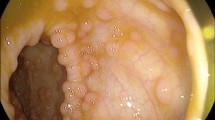Abstract
PURPOSE: Familial adenomatous polyposis is a general growth disorder caused by highly penetrant germline mutations in the tumor suppressor gene APC. The major manifestation of these mutations is colorectal adenomatous polyposis, which, if untreated, leads to early development of colorectal cancer. To prevent this from happening, endoscopic screening of at-risk family members begins early in the second decade of life. Patients with adenomas are offered surgery sometime in that decade. There is a concern about the risk of cancer in teenagers if such surgery is deferred. We conducted this study to investigate that risk. METHODS: A brief survey was sent by facsimile or mail to all familial adenomatous polyposis registries affiliated with the Leeds Castle Polyposis Group. This questionnaire asked for the number of teenage or younger patients in the registry diagnosed with invasive colorectal carcinoma. Other questions addressed the stages and treatment of the tumors and the outcome of their treatment. Patients with carcinoma-in-situ or intramucosal carcinoma were excluded. RESULTS: Replies were received from 26 of 52 registries, but not all questions were answered by all registries. There were 14 patients identified as having invasive colorectal cancer younger than 20 years, the youngest of whom was 9 and the oldest 19. Two patients had two cancers each. Three patients were diagnosed at surgery, and seven were diagnosed when they presented with symptoms. Of the 13 cancers that had staging information, 8 were T1N0M0; 1 was T2N0M0; 2 were TxN1M0; 1 was T3N0M0; and 1 was TxNxM1. Only one patient died of their colorectal cancer. CONCLUSION: Cancer occurs rarely in familial adenomatous polyposis patients younger than 20 years, and only 1 case was reported younger than 15 years. Surgery for colorectal polyposis usually can be deferred safely until at least the age of 15, unless suspicious lesions are found.
Similar content being viewed by others
References
DA Peck KS Watanabe HW Trueblood (1972) ArticleTitleFamilial polyposis in children Dis Colon Rectum 15 23–29
JM Church E McGannon (1995) ArticleTitleA polyposis registry Semin Colon Rectal Surg 6 48–54
HS Debinski S Love AD Spigelman RK Phillips (1996) ArticleTitleColorectal polyp counts and cancer risk in familial adenomatous polyposis Gastroenterology 110 1028–1030
JS Wu P Paul EA McGannon JM Church (1998) ArticleTitleAPC genotype, polyp number, and surgical options in familial adenomatous polyposis Ann Surg 227 57–62
J Church C Burke E McGannon O Pastean B Clark (2001) ArticleTitlePredicting polyposis severity by proctoscopy Dis Colon Rectum 44 1249–1254
Author information
Authors and Affiliations
About this article
Cite this article
Church, J.M., McGannon, E., Burke, C. et al. Teenagers With Familial Adenomatous Polyposis. Dis Colon Rectum 45, 887–889 (2002). https://doi.org/10.1007/s10350-004-6322-x
Issue Date:
DOI: https://doi.org/10.1007/s10350-004-6322-x




